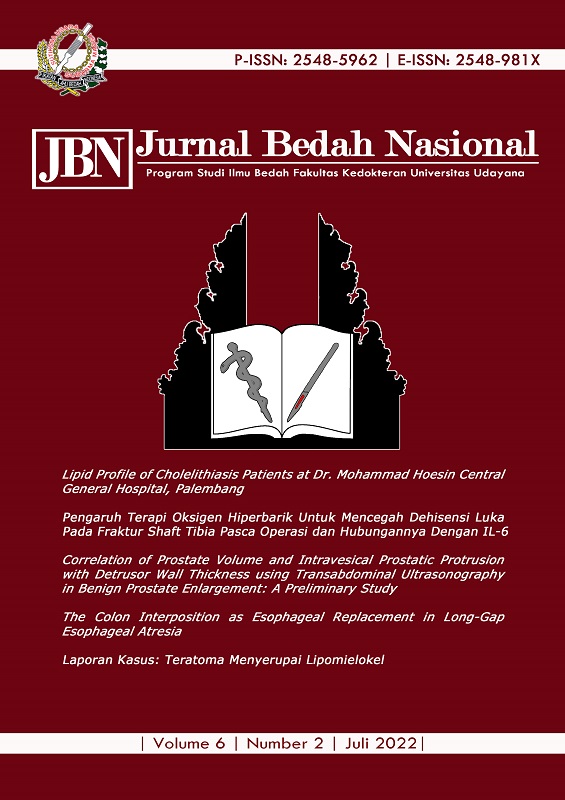Correlation of Prostate Volume and Intravesical Prostatic Protrusion with Detrusor Wall Thickness using Transabdominal Ultrasonography in Benign Prostate Enlargement: A Preliminary Study
Abstract
Aim: Assessed the correlation between prostate volume and intravesical prostatic protrusion with detrusor wall thickness through transabdominal sonographic examination of benign prostate enlargement (BPE). Methods: The study is a paired-group analytical observational cross-sectional study during April – July 2020. Measurements were made of prostate volume, intravesical prostatic protrusion, and detrusor wall thickness using transabdominal sonography. An analysis was carried out to determine the correlation with bivariate analysis and the calculation of the research power. Results: Thirty-four BPE patients with a mean age of 62.41 years were included in the study. The mean value of prostate volume obtained was 44.24 cc; 8.66 mm for intravesical prostatic protrusion; and detrusor wall thickness is 1.49 mm. The correlation value between prostate volume and detrusor wall thickness was 0.12 (p=0.46), while the intravesical prostatic protrusion and detrusor wall thickness were 0.37 (p=0.03). The research power for correlating prostate volume with detrusor wall thickness and intravesical prostatic protrusion with detrusor wall thickness was 10-20% and 50-60%, respectively. Conclusion: There is a very weak correlation between prostate volume and detrusor wall thickness and a weak correlation between the intravesical prostatic protrusion and detrusor wall thickness. Other variables may influence the thickness of the detrusor wall.
Downloads
References
2. Vuichoud C, Loughlin KR. Benign prostatic hyperplasia: epidemiology, economics and evaluation. Can J Urol. 2015;22(Suppl 1):1-6.
3. Zhang W, Zhang X, Li H, et al. Prevalence of lower urinary tract symptoms suggestive of benign prostatic hyperplasia (LUTS/BPH) in China: results from the China Health and Retirement Longitudinal Study. BMJ Open. 2019;9:e022792.
4. Lee SWH, Chan EMC, Lai YK. The global burden of lower urinary tract symptoms suggestive of benign prostatic hyperplasia: a systemic review and meta-analysis. Sci Rep. 2017;7:7984.
5. Güzel Ö, Aslan Y, Balcı M, et al. Can bladder wall thickness measurement use for detecting bladder outlet obstruction? Urology. 2015;86:439-44.
6. Oelke M, Höfner K, Jonas U, et al. Diagnostic accuracy of noninvasive tests to evaluate bladder outlet obstruction in men: detrusor wall thickness, uroflowmetry, postvoid residual urine, and prostate volume. Eur Urol. 2007;52:827-34.
7. Bright E, Oelke M, Tubaro A, et al. Ultrasound estimated bladder weight and measurement of bladder wall thickness-useful noninvasive methods for assessing the lower urinary tract? J Urol. 2010;184:1847-54.
8. Oelke M, Höfner K, Wiese B, et al. Increase in detrusor wall thickness indicates bladder outlet obstruction (BOO) in men. World J Urol. 2002;19:443-52.
9. Oka AAG, Haryanto G, Duarsa GWK. Akurasi pemeriksaan intravesical prostatitic protrusion (IPP) dengan transabdominal ultrasonography (TAUS) untuk menilai bladder outlet obstruction (BOO) pada penderita pembesaran prostat jinak (PPJ). Medicina. 2007;38:26-30.
10. Gandhi J, Weissbart SJ, Kim AN, et al. Clinical considerations for intravesical prostatic protrusion in the evaluation and management of bladder outlet obstruction secondary to benign prostatic hyperplasia. Curr Urol. 2018;12:6-12.
11. Rosadi BA, Mahadewa TGB, Duarsa GWK. Multiplex polymerase chain reaction in detecting etiological causes of bacterial prostatitis associated benign prostatic hyperplasia. Bali Med J. 2016;4:44-7.
12. Duarsa GWK, Lesmana R, Mahadewa TGB. High serum prostate specific antigen as a risk factor for moderate-severe prostate inflammation in patient with benign prostatic hyperplasia. Bali Med J. 2016;4:148-51.
13. Oelke M, Hofner K, Jonas U, et al. Ultrasound measurement of detrusor wall thickness in healty adults. Neurourol Urodyn. 2006;25:308-17.
14. Tokgoz O, Tokgoz H, Unal I, et al. Diagnostic values of detrusor wall thickness, postvoid residual urine, and prostate volume to evaluate lower urinary tract symptoms in men. Diagn Interv Radiol. 2012;18:277-81.
15. Banakhar MA, Al-Shaiji TF, Hassouna MM. Pathophysiology of overactive bladder. Int Urogynecol J. 2012;23:975-82.
16. Franco G, De Nunzio C, Leonardo C, et al. Ultrasound assessment of intravesical prostatic protrusion and detrusor wall thickness-new standards for noninvqasice bladder outlet obstruction diagnosis? J Urol. 2010;183:2270-4.

This work is licensed under a Creative Commons Attribution 4.0 International License.
Program Studi Ilmu Bedah Fakultas Kedokteran Universitas Udayana. 
This work is licensed under a Creative Commons Attribution 4.0 International License.






